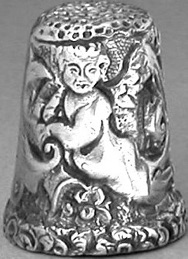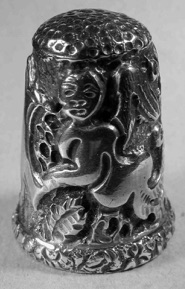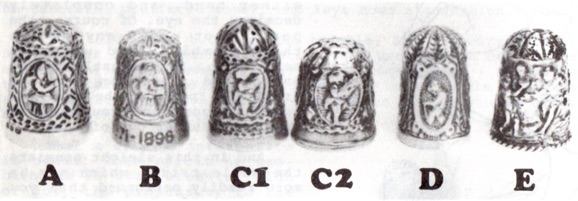More about Thimbles





A previously unidentified thimble
Navigation
William Isbister and Carolyn Meacham
Recently a heavily embossed silver thimble bearing an image of two winged ‘angels’ was shown to us. It was made in two parts and had a decorated attached rim. The top was hand dimpled. One of us (WI) thought that it was of Indian or Oriental origin and the other thought that it was English.

One of us (WI) was not aware of any late 19th century English thimbles that were hand dimpled or made in two parts. It was found, on searching old auction catalogues that a similar thimble had been sold by Christies in 2003 and it was attributed to India. The other of us (CM) felt that the angelic theme was English or Continental as angels do not appear anywhere in Indian religion, folklore or traditions.

Help was sought from ‘experts’, two thought that it was English and two thought ‘Oriental’! One of the ‘experts’ was able to find a very similar children’s thimble with a similar pattern and it had an English hallmark – GU (George Unite) and the date it was assayed was 1899. Clearly thimbles of this type were being made in England at the end of the nineteenth century and although the two thimbles shown do not have hallmarks it is presumed that they were English too.
A search of the literature revealed a paper by Waciorski and Holmes (1) entitled ‘A new type of English silver thimble’ in which six tall narrow rounded topped thimbles with oval medallions containing figures either facing left or right were described. Waciorski and Holmes identified six groups, three were deep drawn and three were made in two parts. Of the 17 thimbles examined, one was marked by George Unite (Group A) and by S. Clifford and Co (Group E), both of London.

Group A – Deep drawn with a star top. Three of the figures in the oval panels face in one direction and one in the other.
Group B – Similar to group A but with two figures facing in each direction.
Group C – Also four oval panels but the figures are cherubs or putti with arrows or musical instruments. Made in two pieces, rather than deep drawn. C1 thimbles are tall and C2 are shorter, possibly older.
Group D – Four oval panels with men holding walking sticks, all facing left. Deep drawn.
Group E – A continuous group scene with no panels. Made in two parts and the star top is similar to group A.

It was concluded that since most of the thimbles were found in England and at least three had English hallmarks they were most likely British made. It was puzzling that some were deep drawn and others were made in two parts. There was a vogue for Indian thimbles at the time so the design of the thimbles was not unsurprising. In a later communication (2) it was recorded that ‘An Indian nineteenth century gold necessaire made in traditional Pertabgarth, Rajputana, jewellery style includes a group A thimble in gold.’ There is thus little doubt that some of these thimbles were made in India. It was also found that a similar stylised floral thimble had been made by Samuel Foskett
Deep drawn and two-part thimbles, the former being milled as opposed to being embossed were being made in Britain by a few thimble makers at the end of the 19th century. Some seem to have been also being made in India however. In view of the hallmark evidence from other similar thimbles, although our thimble did not actually have a hallmark, it would seem that our thimble is an English one. We suggest that it be added to the Waciorski/Holmes classification as Group F
According to Tardy (3) thimbles less that ten pennyweights are still exempt from hallmarking so this may explain the paucity of hallmarks amongst these thimbles. This ruling especially applies to all articles ‘which are highly chased, engraved or embossed’.
References
1. Waciorski E, Holmes EF. A new type of English silver thimble. Thimble notes and queries, 1989; 2: 6.
2. Holmes EF. Correspondence Thimble notes and queries, 1989; 3 :15.
3. Tardy. International Hallmarks on Silver. 5th Edition. pp. 270.
Holmes: na.
Researched and published in 2002/11
Copyright@2013. All Rights Reserved
William Isbister, Moosbach, Germany and Carolyn Meacham, Virginia.
